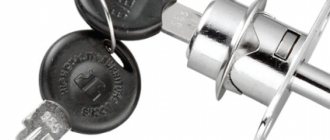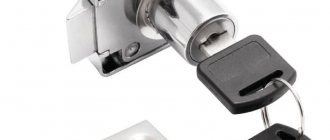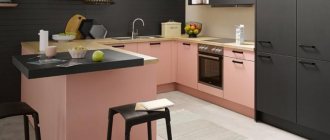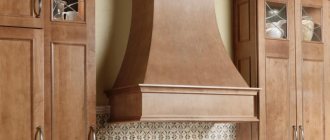The rather complex task of optimal placement of kitchen utensils can be solved by installing roof rails in the kitchen. The railing most often consists of a fairly strong straight or curved tube fixed at a short distance from the wall or ceiling. Objects needed for cooking or other kitchen work are hung on this tube (directly or with the help of additional devices). For example, you can hang frying pans, pots, knives, spatulas, pouring spoons, ladles, skimmers and much more on the railing.
Railing is a pipe fixed at a short distance from the wall or ceiling.
Main types of roof rails
The most common type of railing is a not very thick chrome-plated steel tube, fixed to the wall surface using racks with holes and equipped with additional elements designed for hanging necessary items. These can be hooks, wire loops, nets, cells or rings for plates, bottles or glassware, towel clips, even a stand for a notebook or recipe book.
Depending on the mounting option and design, roof rails can be:
Types of roof rails for the kitchen.
- horizontal, straight or curved;
- suspended, fixed to the ceiling on thin rods;
- vertical, located above the working surfaces of tables;
- combined, consisting of horizontal and vertical sections;
- specialized, for example, magnetic.
Horizontal rails are the most common. They are usually mounted near frying plates, ovens, between the walls of cabinets or above the surface of cutting tables. These roof rails can be used either as a single system or in the form of separate sections located in the required places. In addition, they can be installed in corner areas between walls or cabinets.
Hanging rails are installed in the free zone of the kitchen so that the kitchen utensils hung on them do not interfere with free movement. Often, hanging rails are installed above the bar counter and equipped with holders for glasses, mugs and bottles. You can hang napkins or towels on them.
Vertical railing allows you to save space above the working surface of the table; it can be installed not only on the wall, but also on the side surfaces of kitchen cabinets. If there is not enough free space in the kitchen, combined designs are used, including both horizontal and vertical elements.
Tools for fastening the railing.
Specialized roof rails are usually intended for some type of kitchen utensil. This can be a railing with a basket (for detergents), magnetic (for knives, forks or spoons, etc.).
Most often, for the manufacture of roof rails, as well as fastening and hanging elements for it, steel with a polished chrome-plated or nickel-plated surface is used. However, at the request of the customer, the type of coating can be different, for example, silver, gold or copper, including various patterns and combinations of shades.
To install the railing yourself, you will need the following:
- drill with drills;
- level gauge;
- screwdriver or screwdriver;
- hammer;
- hex wrench;
- screws and dowels.
Accessories
Properly selected accessories improve the functionality of roof rails, expanding the number of items that can be placed on them.
Hooks are the basis of all railing systems. Shelves, nets, containers, and holders are hung on them. They often act as an independent element of the system. Ladles, skimmers, mugs, scissors, etc. are hung on them. Some housewives even hang frying pans and saucepans on hooks.
Shelves are available in a wide variety:
They are great for storing a variety of things. They are convenient for arranging jars and containers for spices. You can place tall and long cans and bottles on shelves with long hangers. They even sell a slanted shelf to hold a cookbook with an open recipe on it, which would be convenient to hang above the work area.
In mesh shelves located near the sink, detergents and cleaning products, fruits that drain after washing, etc. will find their place. Mesh shelves are sold in a variety of configurations: rectangular, square, sector-shaped, round, oval, etc. Mesh shelves are also good for storing spatulas and a slotted spoon near the stove. This is where the stirring and turning processes take place.
The holders can accommodate whisks and spatulas, paper towels and food foil. There are holders for wine glasses, glasses, bottles, cups and other utensils. For paper towels, you can purchase a towel holder with a serrated edge to make them easier to tear off. The place for such an accessory is near the sink.
In addition, you can list such accessories as hanging systems for storing spices, wall-mounted bread bins, baskets, glasses for kitchen utensils, dryers, and soap dishes. The systems can be supplemented with magnetic elements, convenient for storing knives.
Railings are a great way to decorate your kitchen interior with beautiful dishes and other decorative accessories. They can be used as a support to create additional lighting for the work area by placing small directional LED lights on them.
Choosing a location and installing a roof rail
The location for installing the railing is selected based on the location of the kitchen furniture, the functional purpose of the individual elements and ease of use. The length of the supporting steel tube of the railing, regardless of the shape and options for its location, is limited only by the size of the room, the required free space and, of course, aesthetic preferences.
Railing design for the kitchen.
The standard length of the railing is 3 m, but if necessary, it can be shortened or extended using special couplings and inserts. The ends of the pipe are closed with decorative plugs to ensure safety of use and give the structure a finished look.
After the initial preliminary marking of the location, determining the length, number and shape of the rails, we install supporting structures, which will be the basis for attaching the pipes to the load-bearing wall, ceiling or furniture walls in the kitchen.
It should be taken into account that the installation step of the railing fastening elements should not exceed 0.5 m, that is, if a pipe 1 meter long is installed, then the number of points for attaching it to the load-bearing surface should be at least 3, 2 at the edges and 1 in the middle parts.
Markings for installing horizontal or vertical railing should be done using a building level or plumb line at the height required for hanging objects. When marking, you should take into account the size and weight of kitchen utensils hung on the railing and, accordingly, additional holders. If you plan to use the railing for massive objects, then the fastening step should be reduced.
What is a railing system
So, what is a railing system? In English, the word “railing” means “railing”. In the kitchen, a roof rail is nothing more than a long tube or crossbar. Complete with wall mounts and all sorts of accessories, which will be discussed a little later, these tubes make up the railing system.
One of the options for a horizontal railing system and its location in the interior
For the first time, railing systems began to be used in public catering. In the kitchens of cafes and restaurants, some storage cabinets have been replaced with rails. Thus, the cooks always had in front of them the kitchen utensils that they used most often. There is no longer any need to waste precious time and look for the knife or frying pan you need at the moment in numerous drawers and cabinets, which most often have opaque doors. Railing systems have also begun to be used everywhere in bars. And if in kitchens these were most often horizontal and hanging rails, then in bars mostly suspended and vertical railing systems prevailed, in which it was very convenient to place a variety of glasses, tumblers and shot glasses.
Drilling holes for installing roof rails
As a rule, kitchen walls are finished with tiles, which are laid on a concrete base. In this regard, drilling holes for the railing holders must be done with a special drill with a Pobedit tip or diamond coating using an electric drill or hammer drill.
Railing mounting diagram.
After the final marking of the mounting points for the railing supports, “crosses” with a side length of 5-6 mm are applied on the surface of the tile at the drilling points using a diamond glass cutter. In this case, when drilling, the tile will not crack, the hole will be located at the required point.
To install a railing of small thickness with a relatively low mechanical load on it, you can use a drill with a diameter of 5 mm to drill holes. If it is necessary to provide large loads, it is necessary to use drills with a diameter of 8 mm or more. The depth of the holes is determined by the length of the mounting screws and the length of the plastic inserts into which the mounting screws will be screwed.
After the holes for attaching the railing posts are drilled, standard plastic plugs are inserted into them, the length of which corresponds to the length of the mounting screws. With their help it is necessary to secure the supports. Using self-tapping screws, intermediate fastening pins are secured to the ceiling, room walls or furniture walls according to the markings (for fastening load-bearing racks).
Care must be taken to ensure that the screws are tightened all the way and that the supporting pins are installed without any backlash or distortion.
The railing posts are placed on the supporting pins and secured to them using shaped screws. When installing, make sure that the screw heads are not visible. For example, on a horizontal rail they should be located at the bottom of the post, and on a vertical rail they should be located either on the top or bottom side of the posts (depending on the height of the mounting points).
https://vsyakuhnya.ru/www.youtube.com/watch?v=P-e7oRoC4iU
Marking the walls
The fastening of the roof rails in the kitchen should be carried out strictly along a horizontal line. If one side is uneven, the accessories simply won’t stay on the hooks and will begin to slide to one side. As a result, you will have to re-mark the level and redo all the work.
Therefore, the first thing to do is to determine the “horizon” for the railing. To do this you will need a building level. There is no need to measure the distance from the ceiling, cabinet, floor to the railing. You risk receiving false and inaccurate information.
Important point. Before hanging the railing in the kitchen, pay attention to its length. Short systems are attached at two points, rails with a length of more than a meter - at three and four. Multi-tier systems require multiple horizontal openings.
The marking is done. Now you need to drill the holes using an electric drill. The drill must be selected based on the material of your walls. For concrete and ceramic tiles, as a rule, drills with a Pobedit tip and diamond coating are used.
Installing the roof rail tube on the supports
The racks or supports have special holes into which you need to pass the railing tube. The ends of the tube should be as symmetrical as possible relative to the posts; during installation, you should also avoid great force and try not to damage the polished surface of the railing. The final fixation of the tube in the holes of the racks is done with additional screws included in the delivery set of the railing. The ends of the tube are closed with a special plug, consisting of a plastic plug with a chrome tip attached to the plug with a screw. The plastic plug of the plug must be assembled, then hammered into the end of the railing pipe with light blows of a wooden or rubber mallet.
https://vsyakuhnya.ru/www.youtube.com/watch?v=eEc0fqVF4es
The final stage of installing a roof rail in the kitchen is installing the required number of hooks, supporting strips, nets, loops, special holders or rings on the supporting pipe. After this, you can begin hanging and placing various kitchen utensils.
Mounted systems
Hanging systems for railings are functional elements that housewives very often use in the kitchen. The main list of such accessories includes:
- Hooks with or without the possibility of removal, rearrangement.
- Baskets or other containers for storing surface cleaning products or products, such as vegetables.
- Containers for storing baked goods, such as baked goods. They are often produced closed, so you can also install items there that should not be exposed to weather.
- Special holders for glasses, bottles, as well as regular cups and glasses.
- Volumetric cups where you can put small but long objects, such as knives or forks. If you use these items for their intended purpose, then you need to pour salt, sugar, chopped pepper or other seasonings and healthy ingredients into them. Some housewives use them to store small berries, as well as bay leaves and other greens.
- Shelves. There is a wide variety of their choice: hinged, with the ability to close, multi-tiered. They are used to store any elements, sometimes even those distracted from the cooking process.
- Towel holders. If they have several tiers, you can additionally hang potholders on them.











